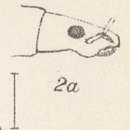Description
provided by INOTAXA archive
Oblong, black, variegated above with a dense clothing of brown and whitish scales, the latter condensed into two faint vittæ on the disc of the prothorax, and various markings on the elytra—a patch on the shoulder, a short irregular oblique fascia on the disc at about one-third from the base, a common transverse fascia beyond the middle, and a large apical patch,—the scales on the under surface whitish, the surface also set with widely scattered, minute, decumbent hairs. Head canaliculate between the eyes, the rostrum short, broad, hollowed anteriorly and deeply emarginate at the apex, the nasal plate short and depressed; antennæ rather short, the scape moderately thickened and barely reaching the middle of the eyes, the latter small and convex. Prothorax cylindrical, nearly as long as broad, sparsely punctate. Elytra subparallel in their basal half, rather convex, comparatively short, the humeri moderately prominent and obliquely truncated in front; punctate-striate, the interstices convex. Legs short and stout; anterior tibiæ denticulate within.
Length 5, breadth 1¾ millim. (♂.)
- license
- cc-by-3.0
- copyright
- Biologia Centrali-Americana
Distribution
provided by INOTAXA archive
Hab.MEXICO, Oaxaca (Höge).
- license
- cc-by-3.0
- copyright
- Biologia Centrali-Americana
Physical description
provided by INOTAXA archive
One specimen. More convex than B. tamaulipanus, the rostrum less excavate in front, the eyes smaller and convex, the upper surface variegate. The much smaller eyes, the less thickened antennal scape, the broader rostrum, the cylindrical prothorax, the shorter, more convex, differently marked elytra, &c., separate the present species from B. acutus.
- license
- cc-by-3.0
- copyright
- Biologia Centrali-Americana

